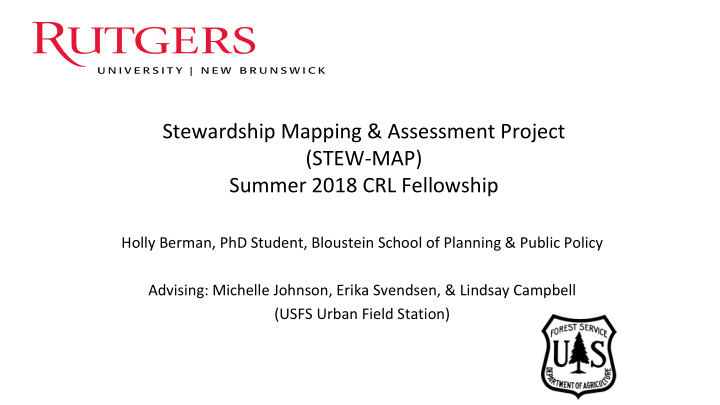



Stewardship Mapping & Assessment Project (STEW-MAP) Summer 2018 CRL Fellowship Holly Berman, PhD Student, Bloustein School of Planning & Public Policy Advising: Michelle Johnson, Erika Svendsen, & Lindsay Campbell (USFS Urban Field Station)
Overview • STEW-MAP background • Analyzing group organizational characteristics • Group professionalization index • Understanding groups that transform • Next steps
STEW-MAP Background • Mapping tool and database of civic environmental stewardship groups • Originated in 2007: Who takes care of NYC? Understand and strengthen civic capacity • Implemented in other cities: Chicago, Baltimore, Seattle, & more • 2017 NYC survey: measures of capacity, turf, networks Civic environmental stewardship: civic actors as stewards who engage in acts of caretaking and claims-making on the environment (Andersson et al., 2014)
Group Organizational Characteristics • Understanding the structure and function of stewardship groups • Information including: stewardship function, site type, focus, staff, year founded, legal designation, communication methods, services provided, budget, impacts & influences • Qualitative coding: metrics, goals, mission statements • White paper with full results currently in draft
Creation of Professionalization Index • Based on index created by Fisher et al., 2012 • Takes into account budget amount and size of staff • Each group assigned professionalization score from 1-5 • 1-2 = low; 2.5-3.5=medium, 4-5=high Professionalization scores for NYC groups (n=294)
Professionalization by Year Founded (n=294)
Primary Stewardship Function NYC (n=680)
Primary Stewardship Function NYC (n=680)
Groups that Transform • Analyzing organizational characteristic specific to groups that identified their primary stewardship function as “transform” (n=45) • Newly added function to the 2017 survey • Focus on how stewardship groups seek to transform systems social- ecological systems (energy, water, waste, communication networks)
Groups that Transform: Theory & Literature • Transformational adaptation, transformations to sustainability, transforming behaviors, & social transformations (O’Brien & Sygna, 2013) • Spheres of transformation: practical, political, personal (Sharma, 2007) → civic stewardship groups operate within and between these spheres • Resilience theory (Olsson et al., 2014) (O’Brien & Sygna, 2013, after Sharma, 2007)
Groups that Transform: Preliminary Findings Sites: community gardens, urban farms, stormwater management systems, food systems Focuses: environment, community improvement & capacity building, food Services provided: educational curricula/trainings, community organizing Drivers of change: extreme weather events, climate change, social movements Mission statements: Most blend environmental & social missions; neighborhood scale; improvement-focused actions
Groups that Transform: Preliminary Findings • Transformation extends past management or improvement • Engage in neighborhood level actions and community outreach • Transform the environment through the social sphere • Small scale goals to contribute to the transformation of larger systems • Driven by community & ecosystem disturbance (extreme weather, climate)
Groups that Transform: Next Steps • Explore individual groups in greater detail to understand how they conceptualize their role in environmental transformation • Qualitative interviews as a possible next step to better understanding this unique set of groups • Analyze network and spatial data “Who decides to initiate transformations? How can power, politics, and interest present barriers, or pathways, to transformation?” (Olsson et al., 2014).
Acknowledgements Thank you! • Advising team at USFS Urban Field Station • Laura Landau (Project manager) • Justine Marchal-Appleton (Research fellow) • Rutgers Center for Resilient Landscapes For more information and updates on STEW-MAP: https://www.nrs.fs.fed.us/STEW-MAP/
References Andersson, E., Barthel, S., Borgström, S., Colding, J., Elmqvist, T., Folke, C., & Gren, Å. (2014). Reconnecting cities to the biosphere: Stewardship of green infrastructure and urban ecosystem services. Ambio , 43 (4), 445 – 453. https://doi.org/10.1007/s13280-014-0506-y Fisher, D. R., Campbell, L. K., & Svendsen, E. S. (2012). The organisational structure of urban environmental stewardship. https://doi.org/10.1080/09644016.2011.643367 O’Brien , K., & Sygna, L. (2013). Responding to Climate Change: The Three Spheres of Transformation. Proceedings of Transformation in a Changing Climate , (June), 16 – 23. Retrieved from www.cchange.no Olsson, P., Galaz, V., & Boonstra, W. J. (2014). Sustainability transformations: A resilience perspective. Ecology and Society , 19 (4). https://doi.org/10.5751/ES-06799-190401 Sharma, M. (2007). Personal to Planetary Transformation. Kosmos Journal , 1 – 7. Retrieved from https://www.kosmosjournal.org/article/personal-to-planetary-transformation/ Svendsen, E. S., Campbell, L. K., Fisher, D. R., Connolly, J. J. T., Johnson, M. L., Sonti , N. F., … Wolf, K. L. (2016). Stewardship mapping and assessment project: a framework for understanding community-based environmental stewardship. Gen. Tech. Rep. 156. Newtown Square, PA: U.S. Department of Agriculture, Forest Service, Northern Research Station. 134 P. , 156 , 1 – 134. Retrieved from https://www.fs.usda.gov/treesearch/pubs/all/50447
Recommend
More recommend